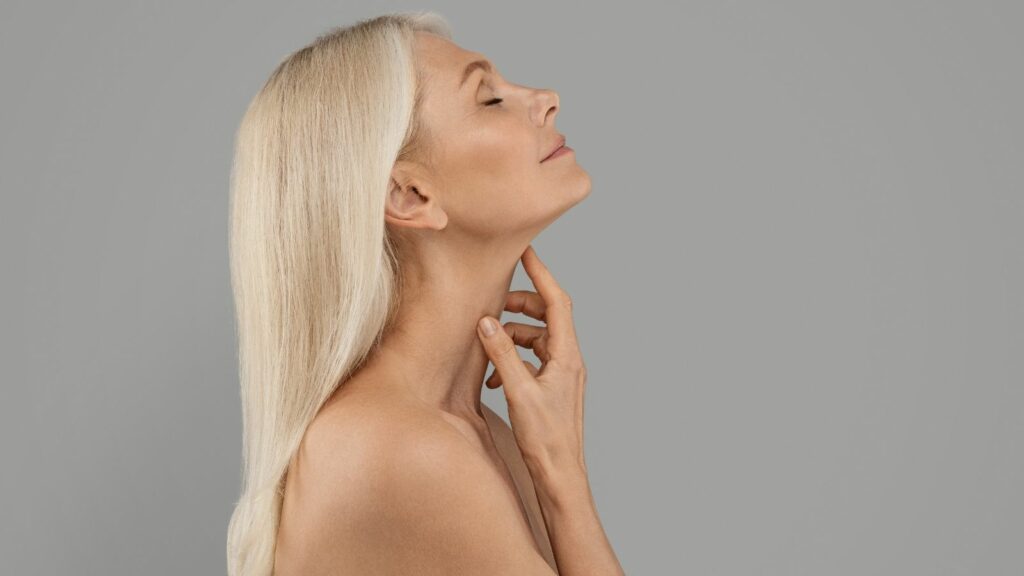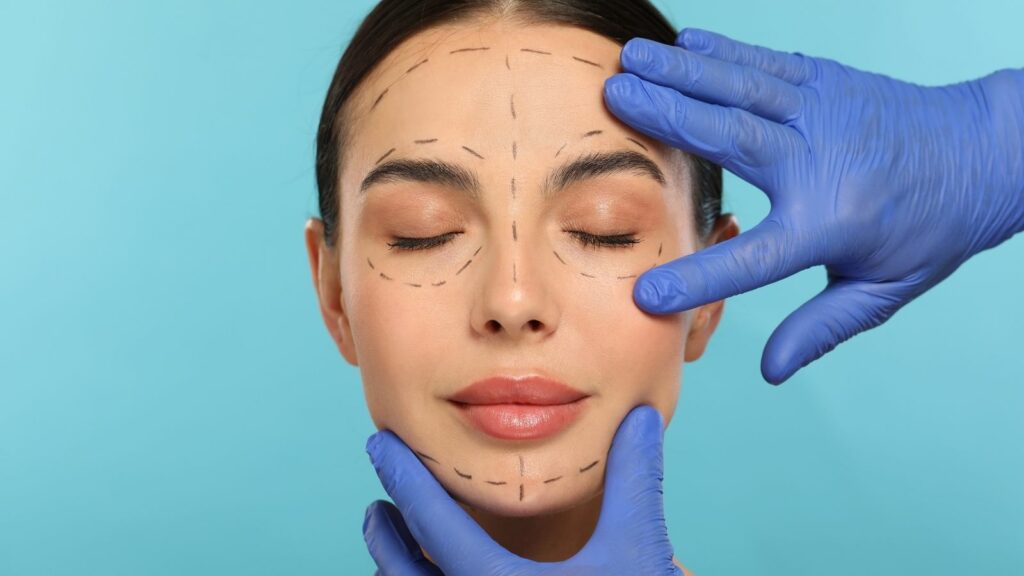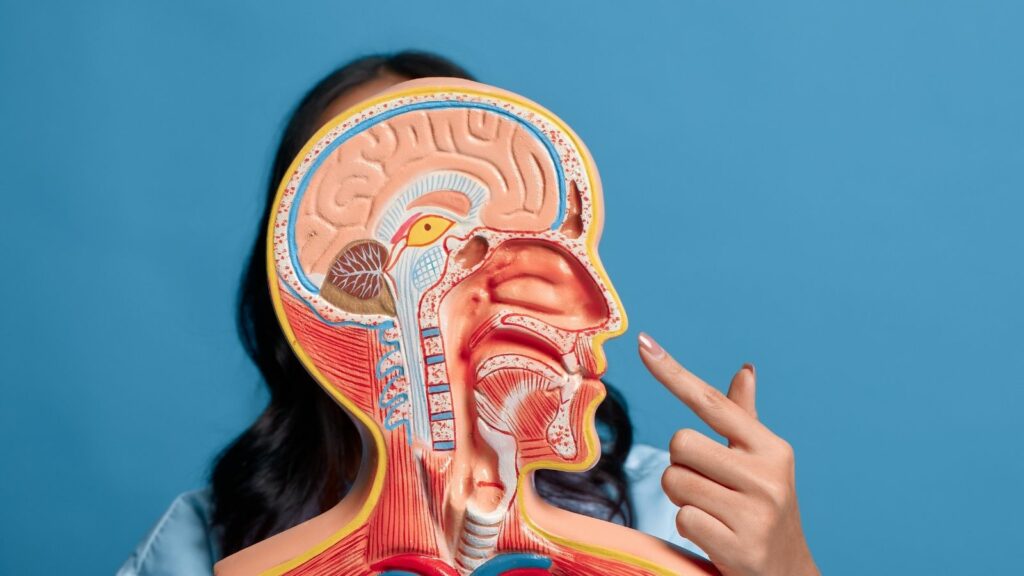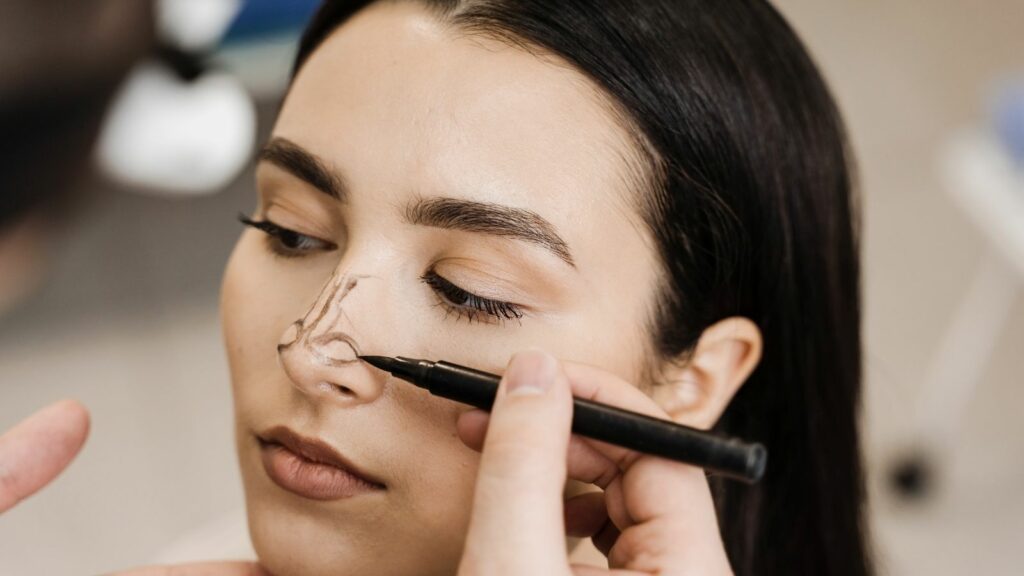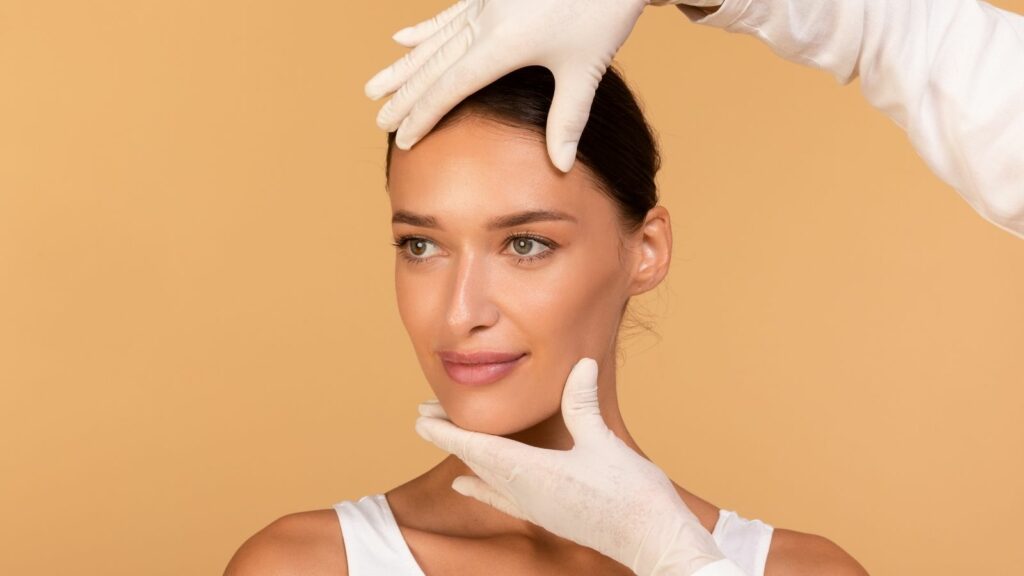Face harmony is achieved when the central position of the nose and the frame created by the jawline and neck present a balanced unity. Rhinoplasty reshapes the center of the face to improve the focal point of expression, while neck lift surgery tightens sagging tissues and sharpens the jawline, providing a strong foundation for this central structure. These two procedures complement each other, especially in profile aesthetics, creating a holistic rejuvenation and proportional harmony that goes beyond isolated improvement. The result is not individually corrected features but a natural and dynamic facial expression in complete harmony with each other.
What is rhinoplasty surgery and what does it aim for?
Rhinoplasty, commonly known as nose aesthetic surgery, is a highly delicate surgical procedure performed to reshape the nose, aiming to provide aesthetic improvement and, if present, correct functional issues. The reasons for undergoing this surgery vary widely. Sometimes the goal is to enhance facial proportions, sometimes to correct deformities caused by trauma, and sometimes—most importantly—to resolve structural problems that make breathing difficult.
In the past, rhinoplasty was mostly associated with reducing the size of the nose. However, the modern surgical approach has changed entirely. Today, the aim is to preserve tissues and create a long-lasting, strong, and natural-looking structure using cartilage support and advanced suturing techniques. At this point, form and function are inseparable. A successful rhinoplasty not only creates a nose that is aesthetically harmonious with the face but also maintains—or even improves—the patient’s breathing comfort.
Why should an ENT and Facial Plastic Surgeon be preferred for rhinoplasty and neck lift?
One of the most important decisions a patient will make in this process is undoubtedly the choice of surgeon. A surgeon with expertise in both Ear, Nose, and Throat (ENT) and advanced training in Facial Plastic Surgery possesses a unique qualification for these procedures. Why? Because ENT training provides in-depth knowledge of the functional structures such as the inner nasal anatomy, sinuses, and airway. This deep anatomical understanding is essential for a rhinoplasty that improves breathing.
Facial plastic surgery expertise adds aesthetic vision and artistic refinement on top of this functional foundation. This ensures the technical precision needed to achieve elegant, natural, and fully harmonious results. Therefore, this dual expertise establishes every surgical plan on three fundamental pillars:
- Safety
- Functional integrity
- Artistic and aesthetic vision
How is facial analysis performed for a successful rhinoplasty?
Predictable and successful rhinoplasty results begin not in the operating room but in the consultation room. Everything starts with correctly and thoroughly diagnosing the underlying anatomy. The surgeon’s first step is to evaluate the patient’s skin quality and thickness, as this determines how the restructured framework will appear and how well minor irregularities will be concealed. Then, a systematic facial and nasal analysis is performed from multiple angles.
The main points evaluated in this analysis are:
Evaluations from the Front View:
- Overall facial symmetry and balance
- Aesthetic lines from the nasal root to the tip
- Width of the nasal wings
- Shape and symmetry of the nasal tip
- Possible deviations in the upper, middle, and lower thirds
Evaluations from the Profile View:
- Height of the nasal dorsum (presence of a hump)
- Projection of the nasal tip
- Angle between the nasal tip and the upper lip
- Proportion between the forehead, chin, and the nose
Evaluations from the Basal View:
- Width and shape of the nasal tip (“boxy,” “bulbous,” etc.)
- Symmetry and shape of the nostrils
- Width of the nasal base
This detailed analysis reveals a simple truth: changing one part of the nose affects all other parts like a domino effect. Therefore, deeply understanding these complex relationships is essential for achieving stable and harmonious results.
What techniques are used in modern rhinoplasty?
Today’s surgical approach includes various advanced techniques and technologies to offer the most suitable solution for each patient’s unique anatomy and aesthetic goals. The two primary surgical approaches are “open” and “closed” rhinoplasty.
What are the differences between open and closed rhinoplasty?
In open rhinoplasty, a small incision is made on the columella—the strip of tissue separating the nostrils. This incision allows the nasal skin to be gently lifted, giving the surgeon direct visibility of the entire bone and cartilage framework. This clear field of view provides great advantage in complex cases such as severe deviations, revision surgeries, or procedures requiring cartilage grafting. This small incision, carefully closed at the end of surgery, usually becomes a barely visible scar over time.
In closed rhinoplasty, all incisions are made inside the nostrils, leaving no visible external scar. This approach is ideal for patients requiring less complex modifications, such as dorsal hump correction or subtle adjustments to the nasal tip. It may also offer advantages such as shorter surgical duration and less initial swelling.
So, which one is better? In fact, there is no definite answer. Large scientific studies have shown no significant difference between the two techniques in terms of patient satisfaction, breathing outcomes, or complication rates. What truly matters is that the surgeon is experienced in both techniques and selects the most appropriate approach based on the patient’s needs and the complexity of the nasal structure.
What does the philosophy of preservation rhinoplasty mean?
This is one of the most significant advancements in modern rhinoplasty. Its main principle is: whenever possible, reshape the patient’s natural anatomy rather than cutting or removing structures. The goal is to preserve the natural structures, ligaments, and support tissues of the nose. As a result, more natural-looking outcomes, a stronger long-term structure, and generally a more comfortable recovery can be achieved.
What advantages does Piezo surgery (Ultrasonic Rhinoplasty) offer?
Piezo surgery is revolutionary in shaping the nasal bones. Instead of traditional tools such as hammers and chisels, this technology uses the power of sound waves. A special device producing ultrasonic vibrations precisely cuts or reshapes only bone tissue without damaging surrounding soft tissues like mucosa, skin, and blood vessels. The greatest advantage for the patient is reduced postoperative trauma. Clinical studies show that this technique is less traumatic than traditional methods and offers significant benefits during recovery.
- Less swelling
- Less bruising
- A more comfortable first week
Am I a suitable candidate for rhinoplasty?
Several important factors determine whether you are an ideal candidate for rhinoplasty. Generally, suitable candidates are expected to have:
- Completed facial growth (typically after age 17–18)
- Good overall health
- Non-smoker
- Clear and realistic expectations
A comprehensive medical evaluation before surgery is essential. However, psychological readiness is just as important as physical health. It is crucial to understand that the goal is improvement and harmony—not perfection. In conditions such as Body Dysmorphic Disorder, where an individual is excessively preoccupied with minor flaws, surgery is not appropriate as it will not resolve the underlying psychological distress. Additionally, patients with structural issues such as septal deviation and breathing difficulties often make excellent candidates, as both aesthetic and functional concerns can be addressed in a single procedure.
How does the aging process occur in the neck area?
The neck is one of the earliest and most prominent areas to show signs of aging. This is because aging in the neck is not limited to the skin surface; it affects multiple layers including the skin, fat, and muscles. Achieving a natural and long-lasting rejuvenation requires addressing changes in all of these layers.
We can examine the effects of aging on the neck in three main layers:
- Superficial Layer (Skin and Subcutaneous Fat): Over time and with sun exposure, the skin loses the collagen and elastin fibers responsible for elasticity. This leads to thinning, wrinkling, and sagging. Accumulated fat in this layer can create the appearance commonly known as a “double chin.”
- Middle Layer (Platysma Muscle): The platysma is a thin, wide muscle extending from the upper chest to the jawline. In youth, the two sides of this muscle meet tightly at the midline. With aging, the muscle loosens and its edges separate, sagging downward. The vertical bands seen in the neck result from this muscle separation.
- Deep Layer (Deep Fat and Glands): Beneath the platysma lies another layer containing fat, muscles, and salivary glands. Enlargement or forward bulging of these deep structures can cause fullness and contour irregularities in the neck. Such problems cannot be solved by skin tightening or superficial liposuction alone.
What are the goals of neck rejuvenation surgery?
The primary goal of neck lift surgery is to reverse age-related changes and create a sharper, younger, and more aesthetically pleasing neck and jawline. Several key aesthetic goals define an ideal youthful neck and jawline:
- A sharp and well-defined jawline without jowl sagging
- An ideal cervicomental angle (the angle between the chin and neck) of 105–120 degrees
- No vertical muscle bands or sagging excess skin
- A smooth and firm neck surface
What techniques are used together during neck lift surgery?
A comprehensive neck lift is not a standard procedure applied the same way to everyone. Instead, it is a personalized approach combining multiple surgical techniques to address each patient’s unique anatomical concerns. The aging process varies among individuals; some mainly struggle with fat accumulation, while others have muscle laxity or skin sagging. Therefore, the proper surgical plan is formed by selecting the right techniques for each problematic layer.
The fundamental components used in neck lift surgery are:
Neck Liposuction (Fat Removal): This specifically targets superficial fat accumulation beneath the skin. Excess fat is removed through a small incision under the chin or behind the ear using a cannula. It is effective for patients with good skin elasticity whose primary issue is a double chin.
Cervicoplasty (Skin Tightening): This is the part of the procedure where excess, sagging skin is surgically removed. Incisions are typically hidden behind the ear’s natural folds and sometimes along the hairline. Through these incisions, the neck skin is lifted, reshaped, and the excess skin is removed to create a smooth and firm surface. It is indispensable for patients with significant skin laxity.
Platysmaplasty (Muscle Tightening): This is the most crucial step in repairing the structural foundation of the aging neck. It directly targets the loosened and separated platysma muscle. One of the most effective techniques is the “corset platysmaplasty.” Through a small incision hidden in the natural crease under the chin, the separated edges of the muscle are located and stitched together from top to bottom like lacing a corset. This maneuver creates a strong internal support, eliminates vertical bands, and sharpens the angle beneath the chin, redefining the neck contour at its core.
Am I a suitable candidate for neck lift surgery?
Generally, healthy non-smokers between the ages of 40 and 60 who are bothered by signs of aging in the neck and jawline are good candidates for neck rejuvenation. Specific conditions evaluated for surgery include:
- Excess sagging skin under the chin and neck, also referred to as “turkey neck”
- Visible vertical bands in the neck (platysmal bands)
- Excess fat accumulation causing jowling or loss of jawline definition
- A poorly defined jawline and a widened neck-chin angle
It is important to remember that the face and neck age together. If the patient has midface sagging or deep nasolabial folds, neck lift surgery is often combined with a facelift to achieve a balanced and complete rejuvenation.
Why should rhinoplasty and neck lift be considered together?
True facial harmony is based not on individual parts but on the unity of the whole. Focusing on only one concern may sometimes lead to unintended imbalance. For instance, creating an elegant and beautiful nose might unintentionally draw more attention to an aging jawline and neck. Conversely, rejuvenating the neck and sharpening the jawline might make an overly large or droopy nose more prominent. At this point, combining procedures allows the surgeon to act like an architect designing the harmony of the entire facial profile rather than a technician fixing isolated issues. This strategic approach aims for a more holistic, balanced, and natural final result.
What are the advantages of combining rhinoplasty and neck lift surgery?
For suitable candidates, combining these two surgeries in one session offers both practical and aesthetic benefits.
- Single Recovery Period: Perhaps the biggest advantage. Instead of two separate surgeries and recovery periods, the patient goes through the entire process once. This reduces the total downtime from work and social life almost by half.
- Cost Efficiency: Since operating room, anesthesia, and surgical team costs are covered once instead of twice, significant cost savings are achieved.
- Less Anesthesia Exposure: A single, slightly longer anesthesia session reduces the overall risks associated with anesthesia exposure.
- Consistent and Harmonious Aging: Rejuvenating different areas of the face at the same time creates a more uniform appearance that ages consistently over time.
What are the risks and considerations of a combined surgery?
Of course, just as there are advantages, there are aspects that require careful consideration. A combined procedure is more extensive than a single surgery.
- Longer Surgery Time: Performing two procedures together increases the duration under anesthesia. This requires an experienced surgical team and meticulous planning.
- More Intense Initial Recovery: Although the total recovery time is shorter, the first few days after surgery may be more intense. Swelling and bruising may appear around the nose, eyes, neck, and jawline.
- Precise Surgical Planning: The surgeon must carefully plan the sequence and steps of both procedures to ensure optimal results.
Who is a suitable candidate for a combined surgery?
Not every patient is a suitable candidate for a combined procedure. Several key factors are considered:
- Excellent Overall Health: The patient must be healthy enough to safely tolerate a longer surgery and recovery period.
- Non-Smoker: Avoiding smoking is essential for safe healing and tissue nourishment.
- Clear and Realistic Goals: The candidate must have clear concerns about both the nose and the aging neck and jawline, and must desire the comprehensive change offered by a combined surgery.
- Commitment to Recovery: The patient must be able to carefully follow postoperative instructions and allocate the necessary time for healing.
What should I expect during the initial consultation?
The consultation is the most important step of the entire journey. It is the meeting where your goals and the surgeon’s vision come together to create your personalized surgical plan. During this appointment, the surgeon will examine your facial structure in detail, take standardized photographs for analysis, and sometimes use computer simulation to help you visualize potential results. An informed patient makes the best decisions, so you should not hesitate to ask all your questions during the consultation.
Some key questions to ask your surgeon are:
- Which surgical techniques do you recommend for me, and why?
- Where will the surgery take place?
- What will the recovery process be like?
- What potential risks and complications should I expect?
- What will the total cost of the surgery be?
How should I prepare for my surgery?
Proper preparation in the weeks before surgery is essential for a safe operation and smooth recovery.
- Medications and Supplements: Medications with a blood-thinning effect—such as aspirin, certain pain relievers, and herbal supplements—will need to be stopped at least two weeks before surgery.
- Lifestyle: Smoking and all nicotine products must be stopped at least 4–6 weeks before and after surgery, as they significantly impair blood circulation and wound healing.
- Logistics: It is important to have someone who can drive you to and from the hospital on the day of surgery and stay with you for the first 24–48 hours.
- Preparing Your Home: Create a comfortable recovery environment by preparing extra pillows to keep your head elevated, keeping medications within easy reach, and ensuring plenty of fluids at home.
What does the recovery timeline look like?
Knowing how the recovery process will progress helps manage expectations and reduces anxiety. The general timeline after combined rhinoplasty and neck lift surgery is typically as follows:
First 24–72 Hours: This period is focused entirely on rest.
- Swelling and bruising are most intense around the nose, eye area, neck, and jawline.
- A nasal splint is placed on the nose, and bandages are used on the neck.
- The head must remain elevated at all times.
- Pain is managed with prescribed medications.
First Week: An important milestone occurs at the end of this week.
- The nasal splint and stitches are removed.
- Neck drains (if placed) and some bandages are removed.
- Although swelling and bruising remain, the patient generally feels better.
- Light walking is encouraged.
Weeks 2–4: Return to social life begins.
- Most visible swelling and bruising improve significantly.
- Most patients feel well enough to return to non-strenuous work.
- Light exercise can be resumed with surgeon approval.
Months 1–3: New contours become evident.
- The new neck and jawline contours become clearer.
- Most nasal swelling subsides, though the nasal tip may still feel firm and numb.
Months 6–12: Final results appear.
- The healing process is completed.
- Remaining swelling at the nasal tip fully resolves.
- The skin adapts to its new structure, and the refined results of both surgeries become clearly visible.
What should I pay attention to in the long term after surgery?
The results of rhinoplasty are permanent, but the face naturally continues to age. The rejuvenating effects of a neck lift usually last 8 to 15 years. To maintain and prolong these beautiful results, several simple yet important habits are essential:
- Sun Protection: Especially in the first year, using high-SPF sunscreen is critical to prevent scar darkening and slow skin aging.
- Healthy Lifestyle: Maintaining a stable weight with balanced nutrition and regular exercise helps preserve the sculpted contours of your neck and jawline.
- Skincare: Medical skincare routines help maintain skin quality and elasticity, supporting longer-lasting surgical results.

